Indian weddings rituals are an embodiment of cultural grandeur and timeless traditions. Each ritual, steeped in history, is a vibrant thread in the fabric of Indian culture. As we embark on this journey, imagine the vivid colors, the resonant music, and the joyful celebrations that define these occasions.
Table of Contents
Pre wedding Rituals
Engagement Ceremony: A Promise of Love

Engagement Ceremony, also known as the Roka, is more than an exchange of rings. Historically, it signified the agreement between families, a tradition that has evolved into a celebration of mutual love. This ceremony varies across regions – in some, it’s a lavish affair, while in others, it remains a private family gathering.
Mehndi Ceremony: Artistry in Henna
Mehndi is more than just body art; it is a symbol of love and commitment. The practice of adorning hands and feet with Mehndi dates back centuries, with its origins traced to ancient India, Egypt, and the Middle East. Over time, Mehndi artistry has evolved, incorporating diverse designs and techniques.

Mehndi holds a special place in Hindu, Muslim, and Sikh weddings, each culture infusing its unique customs and rituals into the ceremony. From intricate bridal patterns to vibrant celebrations, Mehndi is an integral part of the wedding festivities.
The application of Mehndi is a ceremonial affair, with intricate designs adorning the bride’s hands and feet. Family members and friends also partake in the festivities, getting their hands adorned with beautiful patterns. Each region adds its twist – some hide the groom’s and bride’s name in the design, turning it into a playful quest.
Haldi Ceremony: A Golden Glow
The Haldi ceremony, also known as ‘Pithi ceremony’ or ‘Turmeric ceremony’, is a time-honored tradition in Indian weddings. It usually takes place a day or two before the wedding day and is celebrated with great zeal among family and friends.

Turmeric, the main ingredient used in this ceremony, is known for its healing properties and is believed to ward off evil spirits. Applying Haldi paste to the bride and groom is considered auspicious as it is believed to bless them with glowing skin and a prosperous married life
During the ceremony, family members and friends lovingly apply Haldi paste on the bride and groom’s face, arms, and feet. This ritual symbolizes the purification of the couple and is accompanied by heartfelt blessings and prayers for their happiness and well-being.

While the basic essence of the Haldi ceremony remains the same, there are variations in rituals and customs across different regions of India. Family members and friends in north India gather in large numbers, and the atmosphere is filled with music, dance, and laughter. In Punjab, traditional Punjabi folk songs, known as “Giddha” and “Bhangra,” are performed during the ceremony, adding to the festive ambiance.

In South India, the Haldi ceremony, known as “Pelli Pandiri” in Telugu, “Manjal Neerattu Vizha” in Tamil, and “Mangala Snanam” in Kannada, is celebrated with traditional rituals and customs.The ceremony in east India is often combined with other pre-wedding rituals like “Tilak” or “Gaye Holud.”
Wedding Day Rituals
Baraat Procession: A Celebration of Arrival
One of the most lively and exciting parts of an Indian wedding is the Baraat procession.The Baraat is a traditional procession where the groom, accompanied by his loved ones, makes his way to the wedding venue. It is a spectacle to behold, with the sound of drums (dhol), trumpets (shehnai), and lively music filling the air. The groom is often seated on a decorated horse or in a fancy car, adorned with flowers and traditional attire.
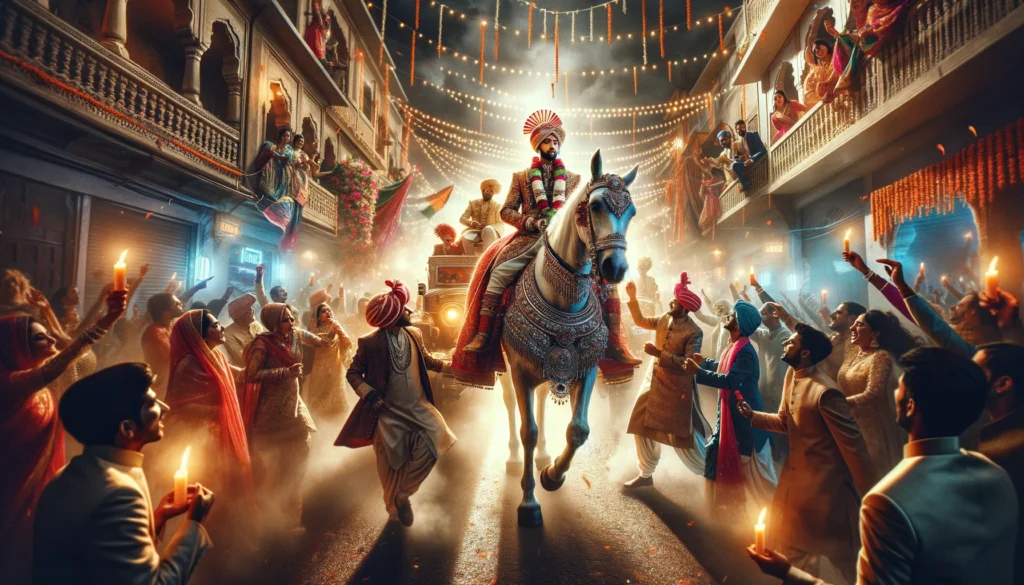
The groom’s family members lead the procession, carrying colorful banners and umbrellas, adding to the festive atmosphere. Friends and relatives dance alongside the groom, celebrating the joyous occasion with enthusiasm and fervor.It is a way for the groom’s family to showcase their happiness and pride, as they welcome the bride into their lives with open arms.
As the Baraat reaches the wedding venue, the groom is welcomed by the bride’s family with traditional rituals and ceremonies. The atmosphere is filled with love and anticipation as the two families come together to celebrate the union of their loved ones.
Jaimala Ceremony: Exchange of Garlands
The Jaimala ceremony stands out as a vibrant and heartfelt celebration of love and unity. This beautiful tradition, also known as the Varmala ceremony, marks the moment when the bride and groom exchange floral garlands, symbolizing their acceptance and mutual respect for one another.

The air is filled with anticipation and excitement as friends and family gather around a beautifully decorated stage, eagerly awaiting the arrival of the bride and groom. The crowd erupts into cheers and applause as they witness this touching moment of love and commitment.
The exchange of garlands during the Jaimala ceremony symbolizes the acceptance of each other as life partners by the bride and groom. It marks the beginning of their journey together as husband and wife, where they pledge to love, honor, and cherish each other for eternity.The act of exchanging garlands also signifies the union of two souls and families.
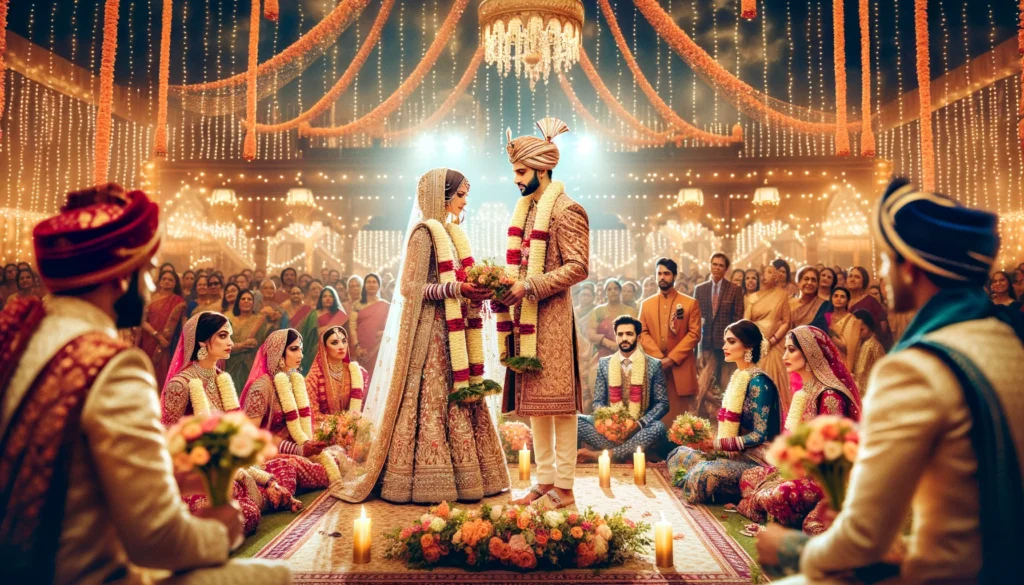
Also in Indian culture, flowers are considered auspicious and are often used in religious ceremonies and rituals. The fragrant garlands exchanged during the Jaimala ceremony are believed to bring good luck, prosperity, and blessings to the newlyweds as they embark on their married life.
Kanyadaan: The Sacred Giving Away
In the heart of Indian weddings lies “kanyadan,” a Sanskrit term translating to “giving away the daughter.” This ancient tradition is deeply rooted in Hindu culture, portraying the emotional and spiritual union of two individuals. Under this ceremony, father symbolically ask the groom to accept his daughter as an equal partner.
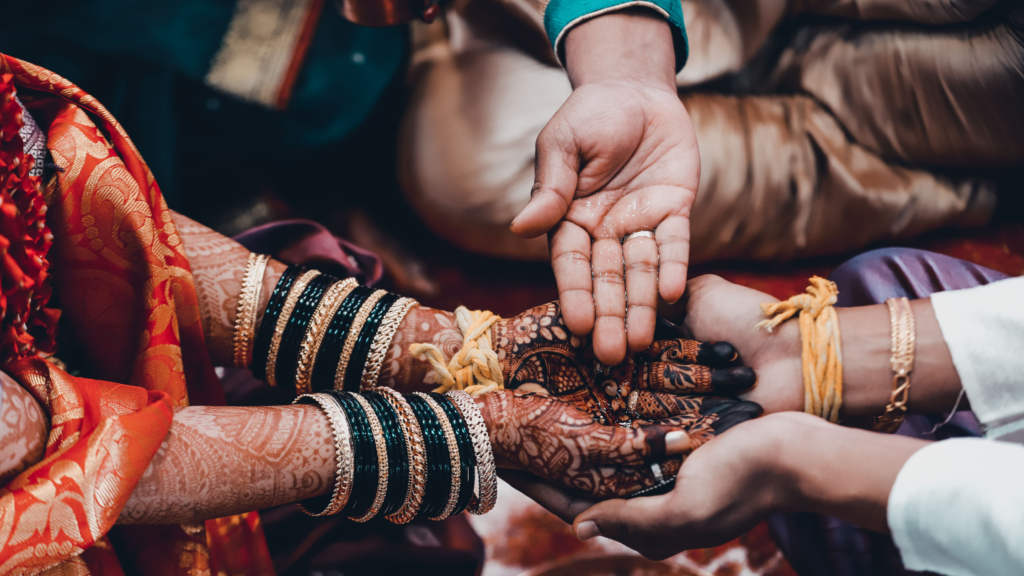
Once the bride enters the wedding arena and exchanges garlands with the groom in the Varmala ceremony, she takes her seat opposite him, facing the sacred fire. The groom extends his right hand, and the bride’s hand is gently placed upon it in a ritual called Hastamilap or Joining of the Hands.
Seven Vows: Circles Around the Fire
The Seven Vows, or Saat Pheras, are the heart of the Indian wedding ceremony. Each vow, taken as the couple circles the sacred fire, signifies a different aspect of marriage.
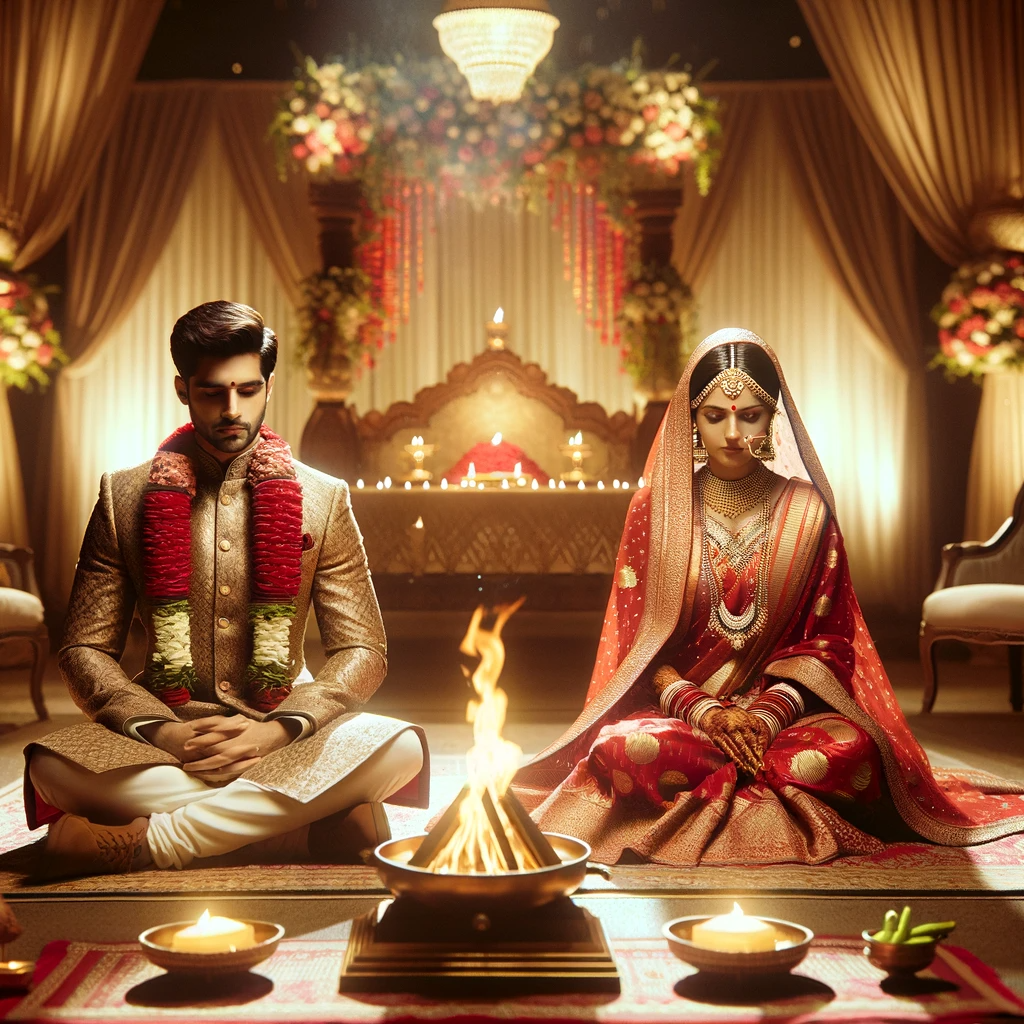
Each phera, or circle around the sacred fire, signifies a promise, a commitment that the bride and groom make to each other. The fire, considered a divine witness in Hindu culture, seals these vows with purity and sanctity.Rooted in ancient traditions, these vows are more than just ceremonial recitations; they are the heartbeats of marital life, guiding couples on their journey together.
The reverence for fire extends to its role in marriage, where it is believed to forge an unbreakable bond between the bride and groom. The fire is not just a witness but a binding force in the marital union, symbolizing purity and the couple’s commitment to each other.
Mangalsutra Ceremony: An Eternal Bond
In the tapestry of Indian weddings, the Mangalsutra ceremony holds a special place, weaving together tradition, symbolism, and familial bonds.The Mangalsutra, derived from Sanskrit words meaning “auspicious thread,” has deep-rooted historical significance in Indian culture.At its core, the Mangalsutra represents the marital status and the well-being of the husband.

It is believed to safeguard the husband’s life and ensure the longevity of the marital union, making it a revered symbol of marriage in Indian society. The groom presents the Mangalsutra to the bride, symbolizing his acceptance of her as his life partner and his commitment to her well-being.
The bride then reciprocates by accepting the Mangalsutra and placing it around her neck, signifying her acceptance of the groom and her willingness to embark on the journey of marriage with him.Following the exchange of Mangalsutras, the couple seeks blessings from their parents, elders, and other family members.
Sindoor Ceremony: A Mark of Matrimony
The Sindoor Ceremony is where the groom applies vermilion to the bride’s hair parting, signifying her status as a married woman. This ritual, rooted in ancient traditions, is a powerful symbol in Hindu weddings. The highlight of the ceremony arrives as the groom takes a pinch of vermilion, known as Sindoor, and applies it to the parting of the bride’s hair, near the hairline.
With each delicate stroke, he seals their bond of love and devotion, marking her as his beloved wife in the eyes of the world.
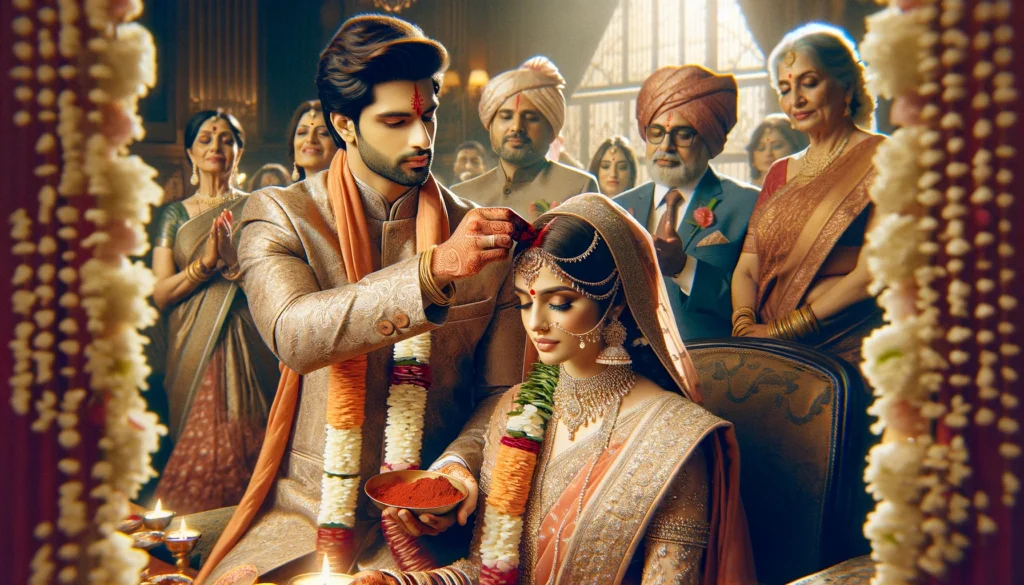
Sindoor holds profound symbolism in Indian culture, representing the bride’s status as a married woman and her commitment to her husband. It is believed to symbolize auspiciousness, fertility, and marital bliss, serving as a tangible reminder of the sacred bond shared between husband and wife
Post-Wedding Rituals
Grihapravesh: Entering a New Life
Grihapravesh marks the bride’s first entry into her new home. This ritual, symbolizing the start of her new life, is filled with customs meant to bring prosperity and happiness. The bride, stepping over the threshold, welcomed with traditional rites.
In some cultures, she is greeted with aarti, while in others, she may have to knock over a pot of rice, symbolizing abundance.
Reception: A Joyous Celebration
The Reception is the culmination of the wedding festivities, a grand affair where the newlyweds are celebrated. Envision a night of music, dance, and feasting, as family and friends gather to bless the couple. While the essence of the reception is universal, its execution varies vastly, with some opting for traditional sit-down dinners and others for lavish buffets and dance floors.
Regional Variations in Rituals
North Indian Weddings: A Tapestry of Traditions
North Indian weddings are a kaleidoscope of rituals, each with its unique charm. From the vibrant Sangeet, a night of music and dance, to the playful Joota Chupai, where the bride’s sisters steal the groom’s shoes, these weddings are a blend of merriment and tradition. The diversity in ceremonies reflects the rich cultural tapestry of the northern regions.
South Indian Weddings: Elegance and Ritual
South Indian weddings are characterized by their elegance and deeply rooted rituals. The Maalai Maatral, where the bride and groom exchange floral garlands, and the Mangalya Dharane, the tying of the sacred thread, are key ceremonies. These weddings, often conducted at dawn, reflect the purity and spirituality of the southern cultures.
Modern Influences on Traditional Rituals
Fusion Ceremonies: A Blend of Old and New
Fusion Ceremonies are a contemporary take on traditional rituals. These weddings mix elements from various cultures, reflecting the couple’s personal tastes. Imagine a wedding where traditional rituals are interspersed with modern elements, a true fusion of styles. This trend is indicative of the evolving nature of Indian weddings, adapting to the changing times.
Destination Weddings: Romance in Exotic Locales
Destination Weddings have become increasingly popular, combining the allure of travel with the sanctity of marriage. Picture a beachside ceremony or a palace wedding, where traditional rituals are set against breathtaking backdrops. These weddings are not just about the location but also about creating a unique experience for the couple and their guests.
Conclusion: A Symphony of Traditions
In conclusion, each Indian wedding ritual is a symphony of tradition, love, and cultural richness. These ceremonies, witnessed and experienced, create memories that endure beyond time, a celebration of the unifying power of love and tradition.


very good publish, i definitely love this website, keep on it
Kredi kartı numarası satın al Google SEO ile marka bilinirliğimizi artırdık. http://royalelektrik.com/
Backlink patlaması SEO çalışmaları sayesinde Google sıralamalarında hızla yükseldik. https://www.royalelektrik.com//esenyurt-elektrikci/
Sosyal medya danışmanı Google SEO optimizasyonu ile organik trafik akışımız büyük ölçüde iyileşti. http://www.royalelektrik.com/esenyurt-elektrikci/
Thank you for your sharing. I am worried that I lack creative ideas. It is your article that makes me full of hope. Thank you. But, I have a question, can you help me? https://www.binance.com/hu/register?ref=FIHEGIZ8
Instagram takipçi satın al Google SEO, işimizi büyütmek için mükemmel bir araç. http://royalelektrik.com/beylikduzu-elektrikci/
Spam yorumu SEO sayesinde Google’da rakiplerimizi geride bıraktık. https://www.royalelektrik.com//esenyurt-elektrikci/
Ucuz takipçi satın al Google SEO, arama motoru sonuçlarında görünürlüğümüzü artırdı. https://www.royalelektrik.com//esenyurt-elektrikci/
Anlık takipçi teslimatı SEO sayesinde Google’da rakiplerimizi geride bıraktık. https://www.royalelektrik.com//esenyurt-elektrikci/
YouTube abone satın al SEO optimizasyonu, dijital pazarlama hedeflerimize ulaşmamıza yardımcı oldu. http://royalelektrik.com/beylikduzu-elektrikci/
Yay google is my king aided me to find this great website ! .
Üsküdar acil su tesisatçısı Su kaçağını bulmada çok başarılılar, hiçbir yer zarar görmedi. https://netgork.com/read-blog/82044
Üsküdar su tesisatı hizmeti Fotoselli musluk montajı için geldiler, çok pratik bir sistem kurdular. Çok memnun kaldık. https://www.mariadda.com/ustaelektrikci
Your article helped me a lot, is there any more related content? Thanks!
Üsküdar su kaçağı fiyatları Su kaçağını çok hızlı bulup onardılar, çok başarılı bir ekip. https://fbadult.com/blogs/6401/%C3%9Csk%C3%BCdar-su-ka%C3%A7a%C4%9F%C4%B1-tespiti
Uyducu Malatya anten tamiri Çanak anten sinyali güçlendirme konusunda mükemmel bir hizmet aldık, teşekkürler. https://kansabook.com/ustaelektrikci
süpürge tamirci numarası Süpürgemde sorun çıktığında ilk tercihim burası. https://wamainuk.com/question/elektrikli-supurge-tamircisi/
Ümraniye süpürge bakımı garantili Çekiş gücü kaybolmuştu, servis sonrası toparladı. https://saopaulofansclub.com/read-blog/5587
süpürge boru temizliği Güler yüzlü çalışanlarla rahat bir servis süreci yaşadım. https://www.vokalayeadel.com/question/supurge-tamircisi/
You rocked this subject and have astounding insights. I also work hard in putting together great content about Internet Marketing, feel free to visit YW9
I don’t think the title of your article matches the content lol. Just kidding, mainly because I had some doubts after reading the article.
su kaçak arıza tespiti Maltepe su kaçağı tespiti: Maltepe’de su kaçaklarına son veriyoruz! https://kryza.network/ustaelektrikci
Your article helped me a lot, is there any more related content? Thanks!
Yakacık su kaçak tespiti Pendik su kaçağı tespiti: Pendik’te su kaçağı sorunlarını güvenle çözüyoruz. https://rogachat.com/ustaelektrikci
kırmadan su kaçak bulma İstanbul Çengelköy su kaçağı tespiti: Çengelköy’de su sızıntılarına kesin çözüm. http://www.mizmiz.de/ustaelektrikci
Beşiktaş su kaçağı tespiti Cihazları çok etkiliydi, kısa sürede su kaçağı tespiti yapabildiler. https://sharezoom.net/ustaelektrikci
Beyoğlu su kaçağı tespiti Maltepe’deki ofisimdeki su kaçağını bulmak hiç kolay değildi ama bu ekip harika çalıştı. https://disl.xyz/socialapp/ustaelektrikci
Gaziosmanpaşa su kaçağı tespiti Duvarlar kırılmadan çözüm sunmaları evdeki tadilat masrafını da azalttı. https://www.leenkup.com/ustaelektrikci
Do you mind if I quote a few of your posts as long as I provide credit and sources back to your webpage? My blog site is in the exact same niche as yours and my users would certainly benefit from a lot of the information you present here. Please let me know if this alright with you. Regards!
Can you be more specific about the content of your article? After reading it, I still have some doubts. Hope you can help me.
Karadeniz su kaçak tespiti Maltepe’deki ofisimdeki su kaçağını bulmak hiç kolay değildi ama bu ekip harika çalıştı. https://vevioz.com/ustaelektrikci
su kaçak tespit robotu Beykoz’daki evimdeki su kaçağını buldular ve kısa sürede onardılar. Hizmetlerinden çok memnunum. https://ceskanaike.com/ustaelektrikci
Kadıköy su kaçak tespiti Hızlı ve Güvenilir Hizmet: “Ekip tesisat, su kaçağı sorunumuza birkaç saat içinde çözüm buldu. https://trngamers.co.uk/ustaelektrikci
Your point of view caught my eye and was very interesting. Thanks. I have a question for you.